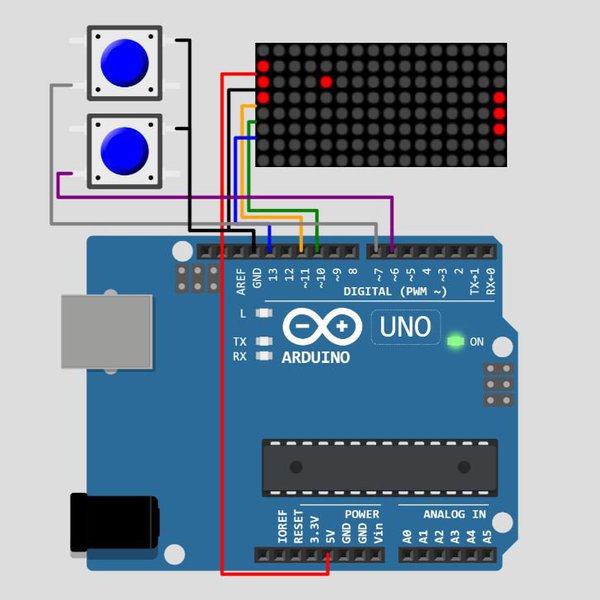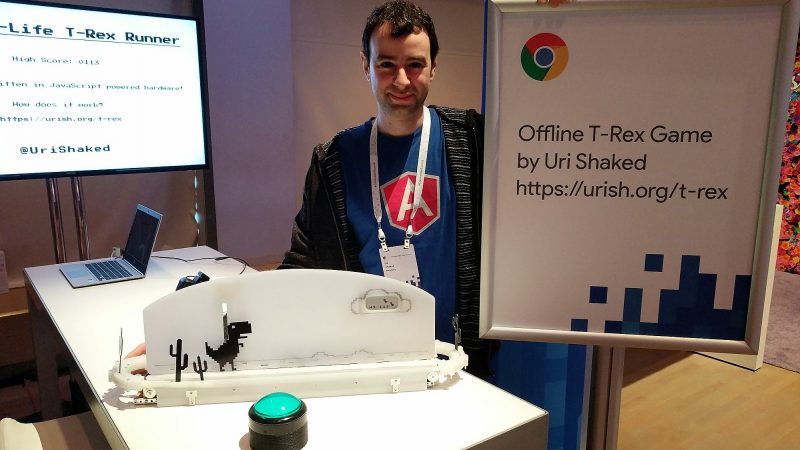-
Hack Chat Transcript, Part 2
04/21/2021 at 20:56 • 0 comments![]() I don't believe those are mutually exclusive.
I don't believe those are mutually exclusive.![]() Talk him into opening it if the commercialization fails.
Talk him into opening it if the commercialization fails.![]() @Uri Shaked Regarding the up comming HADU Pico course, is there something you wish to see/would happen during the course. What would make you happy.
@Uri Shaked Regarding the up comming HADU Pico course, is there something you wish to see/would happen during the course. What would make you happy.![]() Any advice on making money from open source hardware?
Any advice on making money from open source hardware?![]() Or find someone to fund it as open source for him
Or find someone to fund it as open source for him![]() As I see it, making LOTS of money is a skill, which is pretty much orthogonal to being a great developer, creating amazing projects or anything similar.
As I see it, making LOTS of money is a skill, which is pretty much orthogonal to being a great developer, creating amazing projects or anything similar.![]() opensource is awesome but it is a challenge
opensource is awesome but it is a challenge![]() I don't sell any open source things, yet, but have two projects I'd love to be open if I can figure out a way to
I don't sell any open source things, yet, but have two projects I'd love to be open if I can figure out a way to![]() @Dave Blundell I'd start with interviewing Limor from Adafruit and Nate from Sparkfun
@Dave Blundell I'd start with interviewing Limor from Adafruit and Nate from Sparkfun![]() I agree, but he is rather stubborn and wants to change all computing - "his way". I love him, but he can be hard to love. Yeah, i offered to help him raise the money. He just wants to do it his way, and probably does not want his older brother to help him.
I agree, but he is rather stubborn and wants to change all computing - "his way". I love him, but he can be hard to love. Yeah, i offered to help him raise the money. He just wants to do it his way, and probably does not want his older brother to help him.Older brothers can be .... at times.
B^)
I have some and are one!
![]() I can only talk about The Skull, which made something like $1,500, which I don't think it's a LOTS of money
I can only talk about The Skull, which made something like $1,500, which I don't think it's a LOTS of money![]() @Inne I'd love to see creative things people do with what they're learning.
@Inne I'd love to see creative things people do with what they're learning.![]() No, but do that same thing enough times and you can make it something big
No, but do that same thing enough times and you can make it something big@Uri, so a 0.02 percent of ROI?
B^)
![]() I downloaded Wikipedia the last two days. When I was working on Google ngrams, I had a problem that was taking my program 32 hours to run. He memory mapped and optimized and it ran in three minutes. I beg him to let me use that to solve some Internet global problems, but he has some other things in mind. He is thinking about my Wikipedia problem.
I downloaded Wikipedia the last two days. When I was working on Google ngrams, I had a problem that was taking my program 32 hours to run. He memory mapped and optimized and it ran in three minutes. I beg him to let me use that to solve some Internet global problems, but he has some other things in mind. He is thinking about my Wikipedia problem.![]() For instance, in the AVR course, people had an assignment to build a pong game in AVR assembly, from scratch.
For instance, in the AVR course, people had an assignment to build a pong game in AVR assembly, from scratch.![]() It was fun to see how everyone approached this differently, and some people even went the extra mile and added some fun features like a speaker
It was fun to see how everyone approached this differently, and some people even went the extra mile and added some fun features like a speaker![]() @Dan Maloney as Derek Sivers once said, you never know where the lottery tickets are.
@Dan Maloney as Derek Sivers once said, you never know where the lottery tickets are.Pong? Whoa! I feel that could easily get over my head!
![]() I always thought the way they added "English" to the paddle in hardware with the original Pong was a pretty cool hack.
I always thought the way they added "English" to the paddle in hardware with the original Pong was a pretty cool hack.@Dan, so there was "English" involved?
No wonder I was so bad at it!
B^)
![]() @Uri Shaked How about "Find all the covid mentions on the Internet (about 8 billion), identify the owners, contact them, classify the use and purpose, enroll the people in a global cooperative effort. Copy the problem to more computers, keep going till you find everyone and get them working together =--- simple algorithm, hard to get enough computer resources to do. And human buying in and agreement.
@Uri Shaked How about "Find all the covid mentions on the Internet (about 8 billion), identify the owners, contact them, classify the use and purpose, enroll the people in a global cooperative effort. Copy the problem to more computers, keep going till you find everyone and get them working together =--- simple algorithm, hard to get enough computer resources to do. And human buying in and agreement.![]() Here's @Michael Möller pong, I really love the logs he's written along the way:
Here's @Michael Möller pong, I really love the logs he's written along the way:![]()
https://hackaday.io/project/177916-avr-asm-exam
AVR Asm Exam
I attended the AVR assembly course, and it has a Final Project or Examination. This is my submission thereto. Well, it is more than that, it is also my trials and errors on getting there. While the main purpose is to present a software implementation on the wokwi.com simulator, this project will also run on real hardware.
![]() Thanks for the mention.
Thanks for the mention.![]() @Dan Maloney reference please?
@Dan Maloney reference please?@Uri Shaked and @Michael Möller Thanks!
![]() I'll have to look that up -- think I mentioned it in a story I did when the dude who wrote pong passed away...
I'll have to look that up -- think I mentioned it in a story I did when the dude who wrote pong passed away...![]() p.s. @Michael Möller , send me your address later, I'll send you a Skull to keep your brain busy :)
p.s. @Michael Möller , send me your address later, I'll send you a Skull to keep your brain busy :)![]() Ted Dabney, that was his name
Ted Dabney, that was his name![]()
https://hackaday.com/2018/06/05/ted-dabney-atari-and-the-video-game-revolution/
Ted Dabney, Atari, And The Video Game Revolution
It may be hard for those raised on cinematic video games to conceive of the wonder of watching a plain white dot tracing across a black screen, reflecting off walls and bounced by a little paddle that responded instantly to the twist of a wrist.
![]() Looks like I didn't include that nugget. Think it was something I stumbled upon while I was researching. I'll see if I can find my notes
Looks like I didn't include that nugget. Think it was something I stumbled upon while I was researching. I'll see if I can find my notes![]() Google doesn't really help here
Google doesn't really help hereDo you mean this little nugget?
"and bounced by a little paddle that responded instantly to the twist of a wrist."
![]() I got hold of some TTL logic diagrams to build it myself ... in those times .. TTL too expensive. And the TV modulator was "black box"
I got hold of some TTL logic diagrams to build it myself ... in those times .. TTL too expensive. And the TV modulator was "black box"![]() Now, there was some specific set of gates that they added to make it take more skill to play -- the angle of reflection would change a bit depending on which part of the paddle you hit the ball with. It was pretty cool stuff.
Now, there was some specific set of gates that they added to make it take more skill to play -- the angle of reflection would change a bit depending on which part of the paddle you hit the ball with. It was pretty cool stuff.![]() And now people are building AVR pong in assembly in matter of days
And now people are building AVR pong in assembly in matter of days![]() all these spoiled assembly programmers
all these spoiled assembly programmers![]() Oops, look at that -- we're past the top of the hour. Uri, thanks for being on today, this was great - I knew it would be a rambling Hack Chat, but didn't expect molecular evolution and Pong in addition to AVR and RP2040! Great stuff, thanks so much for stopping by!
Oops, look at that -- we're past the top of the hour. Uri, thanks for being on today, this was great - I knew it would be a rambling Hack Chat, but didn't expect molecular evolution and Pong in addition to AVR and RP2040! Great stuff, thanks so much for stopping by!yes, Thanks to all!
![]() Thanks.
Thanks.![]() Thanks!
Thanks!![]() Likewise !
Likewise !![]() Thanks
Thanks![]() 👋
👋![]() Thanks Uri
Thanks Uri![]() And thanks to everyone for the fun questions and great discussion. We're taking next week off, but be sure to check in again on May 5 when we get back together again.
And thanks to everyone for the fun questions and great discussion. We're taking next week off, but be sure to check in again on May 5 when we get back together again.![]() Thanks as well!
Thanks as well!![]() 'till the next time!
'till the next time!![]() Thx Dan
Thx Dan![]() Thank you all!
Thank you all!![]() Looking forward to your next HaDU course, too. Good luck with that!
Looking forward to your next HaDU course, too. Good luck with that! -
Hack Chat Transcript, Part 1
04/21/2021 at 20:55 • 0 comments![]() Hi everyone, welcome to the Hack Chat today. My name is Dan and I'll be moderating today along with Dusan. We're joined by Uri Shaked today, who's doing a HackadayU course soon on RaspPi 2040 and Pico, and completed a course earlier in the year on AVR programming.
Hi everyone, welcome to the Hack Chat today. My name is Dan and I'll be moderating today along with Dusan. We're joined by Uri Shaked today, who's doing a HackadayU course soon on RaspPi 2040 and Pico, and completed a course earlier in the year on AVR programming.![]() "Hello world\n"
"Hello world\n"![]() Welcome Uri! Can you start us off with a little about yourself?
Welcome Uri! Can you start us off with a little about yourself?Howdy!
Is there audio?
![]() Sure!
Sure!![]() @rjtescher - No, just text. Old school, like IRC
@rjtescher - No, just text. Old school, like IRC![]() no audio today, but here's a recommended soundtrack for this hackchat:
no audio today, but here's a recommended soundtrack for this hackchat:- Atom heart mother by Pink Floyd
then
- Court of the Crimson King by King Crimson
TY
![]() hehe, nice!
hehe, nice!![]() About me...
About me...![]() Software engineer by passion, and in the recent year, this passion has grown for projects that also involved hardware
Software engineer by passion, and in the recent year, this passion has grown for projects that also involved hardware![]() Especially ones that challenge my gray cells and teach me new skills. Like building an in-real-life version of the Chrome T-Rex game
Especially ones that challenge my gray cells and teach me new skills. Like building an in-real-life version of the Chrome T-Rex game![]() I feel like I wrote an article on that...
I feel like I wrote an article on that...![]() or trying to decipher encrypted 3D printer firmware for weeks
or trying to decipher encrypted 3D printer firmware for weeks![]() @Uri Shaked do you remember a revelation you experienced when diving deeper into MCU programming, (like "wow now I can do something really cool").
@Uri Shaked do you remember a revelation you experienced when diving deeper into MCU programming, (like "wow now I can do something really cool").![]() About the 🦖?
About the 🦖?![]() decypher files on PC or reverse engineer a code dump that just doesn't have symbol tables?
decypher files on PC or reverse engineer a code dump that just doesn't have symbol tables?![]() I knew it:
I knew it:![]()
https://hackaday.com/2017/11/26/mechanical-build-lets-you-jump-cacti-in-real-life/
Mechanical Build Lets You Jump Cacti In Real Life
Simple to learn, hard to master, a lifetime to kick the habit. This applies to a lot of computer games, but the T-rex Runner game for Chrome and its various online versions are particularly insidious. So much so that the game drove one couple to build a real-world version of the digital game.
![]() (re: printer fimrware)
(re: printer fimrware)![]() @Inne that's a great question.
@Inne that's a great question.![]() I think that 3 days into writing a simulator for AVR, when I got "blink" to work for the first time, I realized how little of the MCU features most code actually uses
I think that 3 days into writing a simulator for AVR, when I got "blink" to work for the first time, I realized how little of the MCU features most code actually uses![]() What’s up ;)
What’s up ;)![]() The AVR instructins or the specific hardware extra IO ?
The AVR instructins or the specific hardware extra IO ?![]() Mostly the hardware extra IO. I don't remember exact numbers, but I think Arduino's blink used between 50% to 80% to the overall instructions.
Mostly the hardware extra IO. I don't remember exact numbers, but I think Arduino's blink used between 50% to 80% to the overall instructions.![]() It that a comment on what programs use, or the boat of Arduino?
It that a comment on what programs use, or the boat of Arduino?![]() *bloat
*bloat![]() but that instructions was really the easier part about the emulator. The peripherals, especially the timers, took a lot longer to write. But for blink, I initially faked the timer with a few lines of code
but that instructions was really the easier part about the emulator. The peripherals, especially the timers, took a lot longer to write. But for blink, I initially faked the timer with a few lines of code![]() Friend of mine was using the library to time a pulse, there is a specific way to do it. He couldnt get it to work for two inputs. So I looked at the code and found there was a special hardware register setup for that - which I then found in the specs, whch is limited to one pin (on the 328)
Friend of mine was using the library to time a pulse, there is a specific way to do it. He couldnt get it to work for two inputs. So I looked at the code and found there was a special hardware register setup for that - which I then found in the specs, whch is limited to one pin (on the 328)![]() @Dave Blundell decrypt the firmware on the PC, using python + numpy/scipy and jupyter:
@Dave Blundell decrypt the firmware on the PC, using python + numpy/scipy and jupyter: ![]() @Nathan Brown what programs actually use.
@Nathan Brown what programs actually use.![]() @uri - Was your simulator written in HLL ? And what assembler package (s) do you use to code AVR?
@uri - Was your simulator written in HLL ? And what assembler package (s) do you use to code AVR?![]() The ATmega328p has 3 hardware timers. Most programs run fine with just Timer 0.
The ATmega328p has 3 hardware timers. Most programs run fine with just Timer 0.![]() @Phil.sydor the simulator is written in TypeScript (a variant of JavaScript), so yes.
@Phil.sydor the simulator is written in TypeScript (a variant of JavaScript), so yes.![]() When I need I just use the GNU assembler. You can use it from directly in Arduino projects, e.g. https://wokwi.com/arduino/projects/289908049496244744 - look at simon.S)
When I need I just use the GNU assembler. You can use it from directly in Arduino projects, e.g. https://wokwi.com/arduino/projects/289908049496244744 - look at simon.S)![]() Other than being a maker with passion for software (especially everything web), electronics and hardware, I also used to be a Salsa dance teacher
Other than being a maker with passion for software (especially everything web), electronics and hardware, I also used to be a Salsa dance teacher![]() and that's also how I met my life partner
and that's also how I met my life partner![]() Nice ; )
Nice ; )![]() @Michael Möller you could probably also do that with INT2/INT3, or even with PCINT which would support any number of pins
@Michael Möller you could probably also do that with INT2/INT3, or even with PCINT which would support any number of pins![]() unless the inputs would fire almost simultaneously, and then you won't be able which one fired first
unless the inputs would fire almost simultaneously, and then you won't be able which one fired first![]() (awkward silence)
(awkward silence)![]() Salsa dancer by night. AVR hacker.. also by night. Cool :)
Salsa dancer by night. AVR hacker.. also by night. Cool :)![]() I'm trying to find the original reference, but lets not derail the chat with my old (and solved) problem.
I'm trying to find the original reference, but lets not derail the chat with my old (and solved) problem. Salsa?
![]() What kind of environments do you like to use? Text editor and makefile?
What kind of environments do you like to use? Text editor and makefile?![]() Salsa. Hold on, I'll find something for you...
Salsa. Hold on, I'll find something for you...![]() Nights can be busy, I guess
Nights can be busy, I guess![]() I was wondering when reading the Datasheet for the RP2040 (for HaDU) for instance, do you have a strategy or read the whole thing mostly chronologically.
I was wondering when reading the Datasheet for the RP2040 (for HaDU) for instance, do you have a strategy or read the whole thing mostly chronologically.![]() I have another question about writing a simulator. What do you use to simulate the "rest" of the hardware? Thinks like I2C components, etc.
I have another question about writing a simulator. What do you use to simulate the "rest" of the hardware? Thinks like I2C components, etc.![]() there you go, @Michael Möller . Me, 12 years ago:
there you go, @Michael Möller . Me, 12 years ago: ![]() @Christopher nowadays? mostly Visual Studio code. Working on Windows machine, and heavily using WSL (Linux integrated into windows).
@Christopher nowadays? mostly Visual Studio code. Working on Windows machine, and heavily using WSL (Linux integrated into windows).![]() Cool
Cool![]() Then for most stuff that involves compiling things I use docker.
Then for most stuff that involves compiling things I use docker.![]() Whoa - that is energetic dancing!!
Whoa - that is energetic dancing!!![]() @Uri Shaked (sidetracking issue: "input Capture Unit", on pin 8 (Portb0), The FreqMeasure library)
@Uri Shaked (sidetracking issue: "input Capture Unit", on pin 8 (Portb0), The FreqMeasure library)![]() For instance, last night I compiled a gdb-multiarch buildroot image to run in an emulator inside the browser, similar to what I did here: https://blog.wokwi.com/running-gdb-in-the-browser/
For instance, last night I compiled a gdb-multiarch buildroot image to run in an emulator inside the browser, similar to what I did here: https://blog.wokwi.com/running-gdb-in-the-browser/![]() What about code visualisation, for static analysis? Some way to show the instructions in a way molecular modeling shows protein structure, show how the code flows in a "folded together" way as a 3d model, more compact than the usual 2d approach?
What about code visualisation, for static analysis? Some way to show the instructions in a way molecular modeling shows protein structure, show how the code flows in a "folded together" way as a 3d model, more compact than the usual 2d approach?![]() @Inne RP2040 is a great example. I got a series when I'm building an emulator for it in a live stream, so you can actually see how I read the data sheet. Also, I showed which parts I focus on in the AVR course (you can find it on Hackaday's YouTube)
@Inne RP2040 is a great example. I got a series when I'm building an emulator for it in a live stream, so you can actually see how I read the data sheet. Also, I showed which parts I focus on in the AVR course (you can find it on Hackaday's YouTube)@Thomas Shaddack protein folding on an AVR?
![]() Cool I'll look them up.
Cool I'll look them up.![]()
https://www.youtube.com/playlist?list=PL_tws4AXg7avNexvQxkfxfEBtvTtBi6Tu
![]() but in general, there's always a section talking about the general architecture. memory map, registers, etc. I usually start there to understand where the code is loaded, where the RAM starts, how is the stack managed, etc.
but in general, there's always a section talking about the general architecture. memory map, registers, etc. I usually start there to understand where the code is loaded, where the RAM starts, how is the stack managed, etc.![]() Thanks @Dan Maloney !
Thanks @Dan Maloney !![]() FYI, I'll post a full transcript after the chat in case anyone needs to refer back for links, etc.
FYI, I'll post a full transcript after the chat in case anyone needs to refer back for links, etc.![]() Some architectures have weird features. For example, ESP32 uses Xtensa, which has something called Windowed Registers
Some architectures have weird features. For example, ESP32 uses Xtensa, which has something called Windowed Registers![]() Do you have a link to Uri's course?
Do you have a link to Uri's course?![]() It's like a micro-stack implemented inside the MCU. It confused me much!
It's like a micro-stack implemented inside the MCU. It confused me much!![]() @Mark J Hughes - the playlist above is Uri's AVR course.
@Mark J Hughes - the playlist above is Uri's AVR course.![]() Thanks @Phil.sydor
Thanks @Phil.sydor![]() His RP2040/Pico course is coming up in May
His RP2040/Pico course is coming up in May![]()
https://www.youtube.com/watch?v=OLV-TSRTTE8
![]() Isn't AVR a generic concept of programming, not a particular piece of hardware or software? I found an AVR instruction set manual at http://ww1.microchip.com/downloads/en/devicedoc/atmel-0856-avr-instruction-set-manual.pdf. But, because they limited the language to a specfic set of hardware, it is not generalizable. Maybe I am wrong about the limited nature of AVR language.
Isn't AVR a generic concept of programming, not a particular piece of hardware or software? I found an AVR instruction set manual at http://ww1.microchip.com/downloads/en/devicedoc/atmel-0856-avr-instruction-set-manual.pdf. But, because they limited the language to a specfic set of hardware, it is not generalizable. Maybe I am wrong about the limited nature of AVR language.![]() @rjtescher Nope. Folding the AVR code in a protein model like way. Or the RNA or DNA structure. Instruction is like an atom, with "bonds" to the previous/next one (and calls and jumps).
@rjtescher Nope. Folding the AVR code in a protein model like way. Or the RNA or DNA structure. Instruction is like an atom, with "bonds" to the previous/next one (and calls and jumps).![]() @Thomas Flummer for the most part, I don't use code visualizations. I did use some visuals when trying to dechiper the 3D printed firmware, e.g. https://medium.com/@urish/visualizing-repetitions-in-string-using-python-and-matplotlib-5e4e1ddff0c9
@Thomas Flummer for the most part, I don't use code visualizations. I did use some visuals when trying to dechiper the 3D printed firmware, e.g. https://medium.com/@urish/visualizing-repetitions-in-string-using-python-and-matplotlib-5e4e1ddff0c9![]()
https://urish.medium.com/visualizing-repetitions-in-string-using-python-and-matplotlib-5e4e1ddff0c9
Medium
Uri Shaked![]()
Visualizing Repetitions in String using Python and Matplotlib
A few months ago, I was accepted to present in BSidesTLV, a cyber security conferences. This was quite unusual for me, as I usually speak at Web / JavaScript / Angular related conferences. The conference covered topics such as malware analysis, block chain security, security vulnerabilities in movie subtitles (that was epic) and even hacking into luxury yachts.
![]() @RichardCollins that's a good question. AVR is an architecture. It's not a concept - it's a specific set of instructions and defined behaviors that are implemented by a family of Microcontrollers.
@RichardCollins that's a good question. AVR is an architecture. It's not a concept - it's a specific set of instructions and defined behaviors that are implemented by a family of Microcontrollers.![]() 🌵,,,🌵,,,,,,,,,🌵,,,🦖,,,,🌵🌵,,,,,🌵,,,,
🌵,,,🌵,,,,,,,,,🌵,,,🦖,,,,🌵🌵,,,,,🌵,,,,@Thomas Shaddack Oh! Okay
![]() Other examples for architectures include ARM, x86 (intel), Xtensa (which I mentioned before, used by ESP8266/ESP32), SPARC, and RISC-V that everyone is talking about
Other examples for architectures include ARM, x86 (intel), Xtensa (which I mentioned before, used by ESP8266/ESP32), SPARC, and RISC-V that everyone is talking about![]() Hi Galia! Very nice visuals, thanks ;-)
Hi Galia! Very nice visuals, thanks ;-)![]() It is my art.🙏
It is my art.🙏![]() Hi hi :)
Hi hi :)![]() But your emulator would allow one to add "128 bit memory space" to some example project. Those instructions would show up in the language, You compile and send HDL to the chip maker and run a big memory project. Simulate to design and test, then get a particular language for particular needs?
But your emulator would allow one to add "128 bit memory space" to some example project. Those instructions would show up in the language, You compile and send HDL to the chip maker and run a big memory project. Simulate to design and test, then get a particular language for particular needs?![]() @Uri Shaked have you done much in the way of glitching or attacks on fuse bits on avr?
@Uri Shaked have you done much in the way of glitching or attacks on fuse bits on avr?![]() @rjtescher The disassembler gives us the primary structure, the chain of instructions. Then apply rules that'd "fold" the 1d-structure to something 3d where the stuff that belongs together naturally clusters. Essentially a 3d graph. With molecules, the rules are the laws of physics governing attraction/repulsion and bond length. Here the rules would be set to make the code structure as obvious as possible, allow us to see the entire code size at once while zooming into the individual sections to the chain of instructions. Without it it is like looking at a map through a thin tube and seeing only a little area - but seeing it in detail.
@rjtescher The disassembler gives us the primary structure, the chain of instructions. Then apply rules that'd "fold" the 1d-structure to something 3d where the stuff that belongs together naturally clusters. Essentially a 3d graph. With molecules, the rules are the laws of physics governing attraction/repulsion and bond length. Here the rules would be set to make the code structure as obvious as possible, allow us to see the entire code size at once while zooming into the individual sections to the chain of instructions. Without it it is like looking at a map through a thin tube and seeing only a little area - but seeing it in detail.![]() Speaking of protein folding, I found Microbiology really intriguing as well. Two years ago I organized an intense 6-week microbiology training program for software hackers
Speaking of protein folding, I found Microbiology really intriguing as well. Two years ago I organized an intense 6-week microbiology training program for software hackers![]() and other than learning a lot about the subject, I couldn't help myself 3d-printing some E-colis: https://urish.medium.com/3d-printing-bacteria-fc48a41d3f76
and other than learning a lot about the subject, I couldn't help myself 3d-printing some E-colis: https://urish.medium.com/3d-printing-bacteria-fc48a41d3f76![]() @Thomas Shaddack I have never heard of this approach. Is there any software package that already does something like this? Or is it a new concept?
@Thomas Shaddack I have never heard of this approach. Is there any software package that already does something like this? Or is it a new concept?I took a course in bioinformatics a dozen or so years ago, interesting. Searching genetic codes with various data structures.
![]() It is one of my pet ideas.
It is one of my pet ideas.![]() Last year I went through many of the protein folding groups for covid on the Internet. They could have used purpose-built massively parallel computers. But no way to design the hardware from the software emulation.
Last year I went through many of the protein folding groups for covid on the Internet. They could have used purpose-built massively parallel computers. But no way to design the hardware from the software emulation.![]() I know IDA has a graph visualization feature, but I rarely found it useful
I know IDA has a graph visualization feature, but I rarely found it useful![]() Organizing a biology course for hackers, the most challenging part (which I didn't anticipate), was to shift their way of thinking from asking: "Why is it like that? What are the rules? Where's the manual?" to simply accept what they observe as given.
Organizing a biology course for hackers, the most challenging part (which I didn't anticipate), was to shift their way of thinking from asking: "Why is it like that? What are the rules? Where's the manual?" to simply accept what they observe as given.![]() The bioprinting is fun! :D The gene-engineering of bacteria with the kit is even more fun. On the wishlist it goes.
The bioprinting is fun! :D The gene-engineering of bacteria with the kit is even more fun. On the wishlist it goes.![]() Biology research is reverse-engineering nature.
Biology research is reverse-engineering nature.![]() The other big challenge is dealing with the fact that in biology, every rule has at least one exception.
The other big challenge is dealing with the fact that in biology, every rule has at least one exception.![]() Only one?
Only one?![]() Sometimes more exceptions than rules, yeah.
Sometimes more exceptions than rules, yeah.![]() Unlike software / hardware, where everything was designed by a human, and if you dig deep enough, you'll probably find the reason why it works in a weird way (e.g. why the A20 line of the system bus is disabled on boot by x86, and you have to tell the keyboard controller to switch it on)
Unlike software / hardware, where everything was designed by a human, and if you dig deep enough, you'll probably find the reason why it works in a weird way (e.g. why the A20 line of the system bus is disabled on boot by x86, and you have to tell the keyboard controller to switch it on)B^) sort of like UN*X then?
![]() Exactly!
Exactly!![]() Anthropology, economics, finance, government, education - every field has infinite exceptions because our models are finite and the universe unlimited.
Anthropology, economics, finance, government, education - every field has infinite exceptions because our models are finite and the universe unlimited.![]() Nature is like a codebase maintained by short-term interns, low paid, unmotivated, doing last minute patches with the least effort necessary before going home. Repeat for couple million years.
Nature is like a codebase maintained by short-term interns, low paid, unmotivated, doing last minute patches with the least effort necessary before going home. Repeat for couple million years.![]() Exactly.
Exactly.![]() But then you find fascinating stuff like virus fragments hidden in bacteria.
But then you find fascinating stuff like virus fragments hidden in bacteria.![]() That's the result of that sleepy 4AM cut/paste.
That's the result of that sleepy 4AM cut/paste.![]() And you start wondering how they even got there....
And you start wondering how they even got there....![]() Thomas Shaddack: Billion years. And rather large numbers of replicas.
Thomas Shaddack: Billion years. And rather large numbers of replicas.![]() haha
haha![]() Interviewer: And how did you get there?
Interviewer: And how did you get there? Nature, exhausted: Trial and error. And error and error.
![]() I think for me, one of the biggest revelations in the biology course, was that what I thought to be junk DNA, is just a piece of code the replicated itself many time
I think for me, one of the biggest revelations in the biology course, was that what I thought to be junk DNA, is just a piece of code the replicated itself many time![]() (google SINE / LINE in human DNA)
(google SINE / LINE in human DNA)![]() And error. And error.
And error. And error.![]() What do you guys want to build? Solar system colonization, warp drives, green the deserts, terraform earths poor regions, lift to orbit, atomic energy (original meaning), education for all? I have a list of abou 20,000 topics that need people working hard and efficiently.
What do you guys want to build? Solar system colonization, warp drives, green the deserts, terraform earths poor regions, lift to orbit, atomic energy (original meaning), education for all? I have a list of abou 20,000 topics that need people working hard and efficiently.![]() Early DNA biologists: Doesnt code for protein, must be junk.
Early DNA biologists: Doesnt code for protein, must be junk.Current theories: It is oart of the folding system, thus control which pieces are exposed, ie which genes are expressed.
Software analogy: Indirect jump
![]() Interviewer: So why does a giraffe have that nerve going all across its neck and back?
Interviewer: So why does a giraffe have that nerve going all across its neck and back?Nature: *sobs loudly*
Well, who knows? Maybe "Junk DNA" was needed at one time for a particular solution, sort of like the "light pen" driver in x86 software.
![]() Yes, if it works, then that is the answer for now, never mind the gadzillions of low cost random previous tries that did not work
Yes, if it works, then that is the answer for now, never mind the gadzillions of low cost random previous tries that did not work![]() haha exactly
haha exactly![]() fascinating stuff. Unfortunately, it's not really accessible for us, hackers (yet?)
fascinating stuff. Unfortunately, it's not really accessible for us, hackers (yet?)![]() @RichardCollins Get out of this stupid rock. The meek shall inherit the Earth, and they can keep it.
@RichardCollins Get out of this stupid rock. The meek shall inherit the Earth, and they can keep it.![]() @Rob Ward Best to remember every experiment and optimize the whole set, not just one particular sequence or outcome.
@Rob Ward Best to remember every experiment and optimize the whole set, not just one particular sequence or outcome.![]() a lot of junk dna seems to serve structural or regulatory function. My hunch is that the function was gradually gained by that piece of code being there and having that particular shape that modulates access to some other shape a bit nearby.
a lot of junk dna seems to serve structural or regulatory function. My hunch is that the function was gradually gained by that piece of code being there and having that particular shape that modulates access to some other shape a bit nearby.![]() Nature: I was young and clueless.
Nature: I was young and clueless.Interviewer: You were millions of years old!
Nature: Exactly!
Interviewer: So did you learn anything from it? Will you get more efficient now?
Nature: ... No?
![]() ...and then comes epigenetics...
...and then comes epigenetics...![]() Yes. I also really liked some of the methods people use nowadays to brute-force reverse engineer genes.
Yes. I also really liked some of the methods people use nowadays to brute-force reverse engineer genes.![]() Nature: "Yes, I evolved gene engineers."
Nature: "Yes, I evolved gene engineers."![]() for instance, there's yeast. it exists. but does it needs all genes? apparently, not.
for instance, there's yeast. it exists. but does it needs all genes? apparently, not.![]() The Internet is going through that kind of random experimentation and evolution. It is possible to measure and guide or modulate part of the process. And most of the pieces are visible.
The Internet is going through that kind of random experimentation and evolution. It is possible to measure and guide or modulate part of the process. And most of the pieces are visible.![]() Interviewer: How did you evolve gene engineers?
Interviewer: How did you evolve gene engineers?Nature: They sort of... happened?
All interesting.
I have a few AVR chips of various types I bought years ago.
I also have an ST-500 programmer from before then.
What do I need / need to do to do assy lang. on my AVRs?
![]() But yeah. And it's fascinating, how things evolved to us talking about it - and more
But yeah. And it's fascinating, how things evolved to us talking about it - and more![]() The ones that keep their heads down and concentrate on reproducing will inherit the earth. Obsession with money is a dangerous distraction.
The ones that keep their heads down and concentrate on reproducing will inherit the earth. Obsession with money is a dangerous distraction.![]() @rjtescher Alcohol. Significant amount. And assembler.
@rjtescher Alcohol. Significant amount. And assembler.![]() how do we figure out which genes can be omitted? brute-force search
how do we figure out which genes can be omitted? brute-force search![]() Haha :)
Haha :)@Uri Shaked Muntz did that with Televisions
![]() Yes, GNU assembler should do.
Yes, GNU assembler should do.![]() If you need to exact command line ping me after, I'll look it up for you
If you need to exact command line ping me after, I'll look it up for you![]() The "useful" or "necessary" genes depend on the context. A better field equation is not needed if you are building water supplies for Mars.
The "useful" or "necessary" genes depend on the context. A better field equation is not needed if you are building water supplies for Mars.![]() @rjtescher And some hello-world examples. I usually start learning with modding something that already exists, even if small.
@rjtescher And some hello-world examples. I usually start learning with modding something that already exists, even if small.![]() yes, actually the AVR course has some pieces you can use to stich together an hello world in assembly
yes, actually the AVR course has some pieces you can use to stich together an hello world in assembly![]() @rjtescher But consider writing it in C. If you don't need clock-tight timing or save every possible byte, C is the lazier option. I swear on (and sometimes at) avr-gcc.
@rjtescher But consider writing it in C. If you don't need clock-tight timing or save every possible byte, C is the lazier option. I swear on (and sometimes at) avr-gcc.@Uri Shaked and @Thomas Shaddack , I came unprepared, I'll dig into Uri's .IO and YT after this....
![]() Definitely do it.
Definitely do it.![]() And come back with questions, many, please :)
And come back with questions, many, please :)![]() Questions are fun. The only stupid question is the one that was not asked, but should.
Questions are fun. The only stupid question is the one that was not asked, but should.![]() Are you a unicorn?
Are you a unicorn?![]() Me? Do I like barfing rainbows? :P
Me? Do I like barfing rainbows? :P![]() ...do I *look* like...
...do I *look* like...![]() ;-)
;-)@Uri, I am a Unique Orn(ery) S.O.B. B^)
![]() hehe
hehe![]() Programming is a mainly hard slog with deterministic expectations, interspersed with random genius events, teasing them apart is much harder. Nature is entirely random, so much, much harder to "follow any logic".
Programming is a mainly hard slog with deterministic expectations, interspersed with random genius events, teasing them apart is much harder. Nature is entirely random, so much, much harder to "follow any logic".![]() another fun chip is the ESP8266/ESP32. With C you can share big chunks code between the platforms, and the embedded approach is similar.
another fun chip is the ESP8266/ESP32. With C you can share big chunks code between the platforms, and the embedded approach is similar.![]() But if you do like torturing yourself with hardcore AVR internals, there's also my latest hardware project, The Skull
But if you do like torturing yourself with hardcore AVR internals, there's also my latest hardware project, The Skull![]() Though NNs kind of throw some arbitrariness / randomness into the hot mess
Though NNs kind of throw some arbitrariness / randomness into the hot mess![]() Nature has a lot of logic. The problem is that it has so much logic it appears chaotic. (Chaotic. Not random.)
Nature has a lot of logic. The problem is that it has so much logic it appears chaotic. (Chaotic. Not random.)![]() Today someone from Brasil actually managed to solve all the 3 parts of the challenge for the first time
Today someone from Brasil actually managed to solve all the 3 parts of the challenge for the first time![]() My brother, Clif, wrote a native Javascript compiler. He can compile to HDL. So you can take any program and, in principle, "print" the code to hardware.
My brother, Clif, wrote a native Javascript compiler. He can compile to HDL. So you can take any program and, in principle, "print" the code to hardware.![]() Is that compiler on Github?
Is that compiler on Github?![]() Printing hardware... that'd be royal fun. 3d nanoprinting of organic semiconductors...
Printing hardware... that'd be royal fun. 3d nanoprinting of organic semiconductors...![]() I'd love to take a look
I'd love to take a look![]() No, he wants to commercialize it. I begged him to make it open, but he would rather make LOTS of money.
No, he wants to commercialize it. I begged him to make it open, but he would rather make LOTS of money.![]()
 Lutetium
Lutetium




 No, but do that same thing enough times and you can make it something big
No, but do that same thing enough times and you can make it something big










